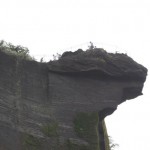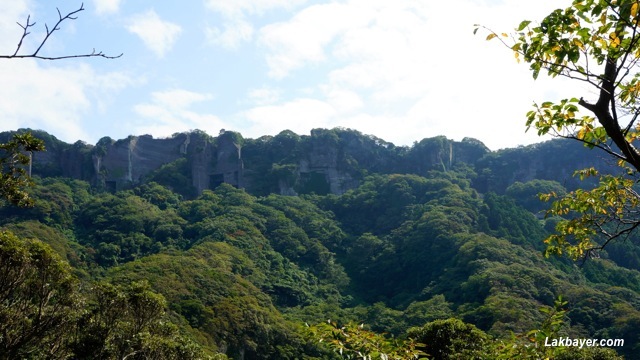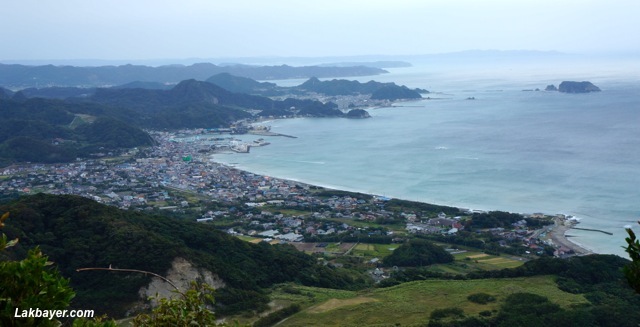Mt. Nokogiri is a 329.4 meters tall mountain located at the southwest part of Chiba Prefecture and lies in the city of Futtsu and the town of Kyonan. It forms the boundary between Kazusa and Awa areas of the Boso Peninsula.

It is one of the best day trip from Tokyo that provides good hiking and fascinating scenery but is less popular than those located in the western part of the city.
Saw-Toothed Mountain
Nokogiriyama literally means “saw mountain” as the mountain has serrated ridge, like the teeth of a saw. The extraordinary shape of the mountain was attributed to its quarrying history – it used to be a production area for stones used in construction during the Edo Period. The Bashu-stone from here was shipped from the part of Kanaya to Tokyo to build navy ports and fortress, as well as buildings including the Yasukuri Shrine located in Chiyoda, Tokyo and the Waseda University. The stone cutting activity ended in the 1970’s and since then the mountain became a tourist and hiking destination for its unique cliffs formed from quarrying and the amazing view of Tokyo Bay at the mountain top.
 Highlights
Highlights
Other than the wonderful scenery that the mountain provides, there are also other sights that attract tourists to visit the mountain.
 “Jigoku Nozoki”
“Jigoku Nozoki”
A small rock balcony overhanging a high cliff in the mountain and serves as the observation deck. It provides a panoramic view of Tokyo Bay, Yokohama City, Miura Peninsula, and Boso Peninsula. During a fine weather, Mt. Fuji and the Izu Peninsula can also be seen. The observation deck is given the name because it makes visitors feel like they are peeking inside hell as they look down over the world below from the protruding balcony.
There is also a restaurant near the observation deck which is covered with glass so that people enjoy the scenery while having their meals. An exhibit of historical materials on the stone-cutting operation in the mountain is also on display near the deck to provide visitors with a bit of education.
“Nihon-ji Temple Complex”
A Zen sect temple located a short walk along a rough path from the observation deck, in the southern side of the mountain. It is an important cultural property of Japan as it is the oldest Buddhism temple in Tokyo, which was built in 725. Many famous Buddhist monks trained at this temple and the temple also holds valuable constructions & Buddha structures including the statues of Nio which is a mascular guardian of Buddha.
Yakushi Nyorai Daibutsu or the Great Buddha which is the Buddha of healing and medicine is also located in the complex. It is a 31.05 meters giant seated carving of Buddha which is the largest pre-modern stone carved Daibutsu in Japan. It was orginaly built in 1783 but around the end of the Edo period, the statue was damaged by weathering and earthquake and it lost almost all its shapes. It was however, restored in 1966.
 Another important structure in the complex carved in one of the quarry walls is the Hyaku-Shaku Kannon or the hundred stone statues of Kannon Bodhisattva, a tall relief image of the Buddhist Goddess of Mercy. It is also known as merciful disciple or Budhha associated with compassion.
Another important structure in the complex carved in one of the quarry walls is the Hyaku-Shaku Kannon or the hundred stone statues of Kannon Bodhisattva, a tall relief image of the Buddhist Goddess of Mercy. It is also known as merciful disciple or Budhha associated with compassion.
 There are also 1,500 hand-carved Rakan statues spread out in the temple complex. It was created by craftman Kangoro Ono and his students in 1779, which took them 21 years to complete. These Buddhist disciples who have attained nirvana were carved standing, sitting, occasionally reclining, smiling, frowning, and sometimes scowling. However, at present, there are only about 538 statues left from the original 1,500 due to the nationwide wave of anti-Buddhist violence, which was prompted by the government’s establishment of the Shinto as the state religion and the outlawing of Buddhist practice at the start of the Meiji period in 1868.
There are also 1,500 hand-carved Rakan statues spread out in the temple complex. It was created by craftman Kangoro Ono and his students in 1779, which took them 21 years to complete. These Buddhist disciples who have attained nirvana were carved standing, sitting, occasionally reclining, smiling, frowning, and sometimes scowling. However, at present, there are only about 538 statues left from the original 1,500 due to the nationwide wave of anti-Buddhist violence, which was prompted by the government’s establishment of the Shinto as the state religion and the outlawing of Buddhist practice at the start of the Meiji period in 1868.
A big Cycad tree which resembles palms or tree ferns which is over 800 years old is also one of the icon in the complex.
Climbing Mt. Nokogiri
Visitors can reach the mountain top either by hiking, taking the ropeway or by car.
Hiking
Visitors who are feeling energetic can climb the mountain summit by foot either from the south or the Kanaya area, which is near the Hamakanaya JR station or from the north or the Kyonan-machi area, which is near the Hota JR station.
For hikers taking the Kanaya trail, the hike takes around 1 hour with the trails starting about 15 minutes from the port or 10 minutes from the train station. Take a left turn on the first street from the JR station and go straight ahead until you reach a crossroad with the hiking map.
Most of the hiking trails were made by the quarriers and include natural stone stairs, rough path and steep slopes, as well as views of nearby cliffs and Tokyo Bay on the way. People enjoy climbing the mountain with ease throughout the year.
 Series of stairs along the trail.
Series of stairs along the trail.
Nokogiri Ropeway
 Most tourists especially those with children opt to take the ropeway to the summit. It runs near the Hamakanaya station to a look-out deck near the top of the temple percint with service every 5 minutes. The ride takes around 3-5 minutes with a 300 meters steep climb on its 680 meters oblique distance. The cable car is far from the ground, so despite the short trip, it will still definitely be exciting.
Most tourists especially those with children opt to take the ropeway to the summit. It runs near the Hamakanaya station to a look-out deck near the top of the temple percint with service every 5 minutes. The ride takes around 3-5 minutes with a 300 meters steep climb on its 680 meters oblique distance. The cable car is far from the ground, so despite the short trip, it will still definitely be exciting.
| Nokogiri Ropeway Fares | ||||||
| Private | Group (more than 25 people) | |||||
| General | Students | |||||
| Adult | Child | Adult | Child | Adult | Child | |
| One-way | ¥ 500 | ¥ 250 | ¥ 450 | ¥ 230 | ¥ 400 | ¥ 230 |
| Round-Trip | ¥ 900 | ¥ 450 | ¥ 810 | ¥ 410 | ¥ 720 | ¥ 410 |
* Children from 6 to 11 years of age are charged as Child Fare.
By Car
The top of the mountain is reachable by car via the Nokogiriyama Tozan Motor Road.
Accessibility
The fastest way to reach Mt. Nokogiri from central Tokyo is via JR Sazanami, a limited express train service which runs between Tokyo and Tateyama via the Keiyō Line and Uchibō Line. The trip from Shinjuku to Hamakanaya Station takes about 1 hour and 48 minutes and costs ¥3,800 (one-way fare).
Another option is taking the JR Sobu/Chuo Line from Shinjuku to Chiba and changing to the JR Uchibo Line to Hamakanaya Station. The trip costs around ¥1,940 but takes around 2 hours and 40 minutes.


Useful Info:
Nokogiriyama Ropeway Co.
Address: 4052-1 Kanaya Futtsu Shi Chiba Ken 〒299-1861
Website Site: Mt-Nokogiri.co.jp
Inquiries: 0439-69-2314
Hours: November 16th to February 15th 9:00 to 16:00
February 16th to November 15th 9:00 to 17:00
During Summer: 9:00 to 18:00



